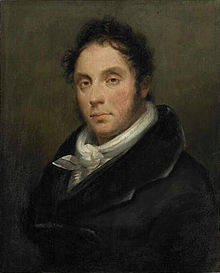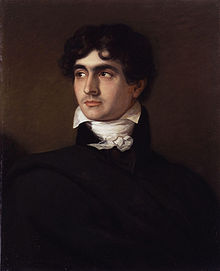Lord Byron to Doctor Polidori
Lord Byron to Doctor Polidori – wiersz amerykańskiego poety Edgara Lee Mastersa[1], opublikowany w tomie Starver Rock, wydanym w 1920. Pod względem gatunkowym utwór jest monologiem dramatycznym. Stanowi imaginacyjną wypowiedź romantycznego angielskiego poety George’a Gordona Byrona do jego znajomego lekarza Johna Williama Polidoriego, znanego szerzej nie z powodu jego praktyki medycznej, ale z napisania noweli Wampir. Został ukształtowany na wzór podobnych monologów Roberta Browninga[2]. Jest napisany wierszem białym (blank verse[3]), czyli nierymowanym pięciostopowym jambem[4], innymi słowy sylabotonicznym dziesięciozgłoskowcem[5], w którym akcenty padają na parzyste sylaby wersu.


- No more of searching, Doctor — let it go.
- It can’t be lost. I have a memory
- I put it in a drawer, or again
- I seem to see me tuck it in a pocket
- Of some portmanteau. If you find the letter
- Deliver it to Moore. But if it’s lost,
- The story is not lost. I tell you this
- To save the story from my side. Attend!
- It was this way:
- Allegra had become
- A child requiring care, and nutritive
- Instruction in religion, morals, well,
- They call me blasphemer and sensualist,
- But read my poems. Christianity
- Was never of rejected things with me.
- The Decalogue is good enough, I think.
- And Shelley’s theories, atheist speculations
- I never shared — nor social dreams.
Edgar Lee Masters, Lord Byron to Doctor Polidori
Przypisy
edytuj- ↑ Edgar Lee Masters, poet. poets.org. [dostęp 2017-02-28]. (ang.).
- ↑ Ronald Primeau: Beyond Spoon River: The Legacy of Edgar Lee Masters. books.google.pl, 1981. [dostęp 2017-02-28]. (ang.).
- ↑ Jacek Baluch, Piotr Gierowski: Czesko-polski słownik terminów literackich. Kraków: Wydawnictwo Uniwersytetu Jagiellońskiego, 2016, s. 68-69. ISBN 978-83-233-4066-9.
- ↑ blank verse, [w:] Encyclopædia Britannica [dostęp 2017-02-28] (ang.).
- ↑ Blank Verse. PoetryFoundation.org. [dostęp 2017-02-28]. (ang.).
Bibliografia
edytuj- Edgar Lee Masters: Starved Rock. ia800200.us.archive.org, 1920. [dostęp 2017-02-27]. (ang.).